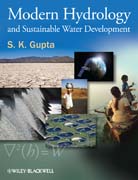
The material of this book will derive its scientific under-pinning from basics of mathematics, physics, chemistry, geology, meteorology, engineering, soil science, and related disciplines and will provide sufficient breadth and depthof understanding in each sub-section of hydrology. It will start with basic concepts: * Water, its properties, its movement, modelling and quality * The distribution of water in space and time * Water resource sustainability Chapterson 'global change' and 'water and ethics' aim respectively to emphasize the central role of hydrological cycle and its quantitative understanding and monitoring for human well being and to familiarize the readers with complex issues of equity and justice in large scale water resource development process. Modern Hydrology for Sustainable Development is intended not only as a textbook forstudents in earth and environmental science and civil engineering degree courses, but also as a reference for professionals in fields as diverse as environmental planning, civil engineering, municipal and industrial water supply, irrigation and catchment management INDICE: "1.1 Table of contents.1) FUNDAMENTALS OF HYDROLOGY.a) Peculiar Physical Properties of Water.i) Boiling and Freezing points of water.ii) Latent heat.iii) Heat Capacity.iv) Thermal expansion.v) Density, Viscosity.vi) Surface tension and Capillarity.b) Water Quantity and Quality.i) Quantity (volume and Flow rate).(1) Precipitation/snowmelt/gauges, networks, data sources/ accuracy.(2) Evaporation pans, evaporation and transpiration.(3) Surface water flow measurements (Weirs, flumes and gauges).(4) Soil moisture (soil-water pressure, tension/ retention).ii) Quality parameters.(1) pH.(2) DO.(3) Temperature.(4)Conductivity.(5) Chemical parameters.(6) Biological parameters.c) Quantity and Timing of Flow.i) Physics of Water Flow.(1) Visible Flow: Surface Water.• Uniform flow; Manning Equation.• Channel routing; reservoir routing.(2) Soil Water.• Infiltration Process/ rate.(3) Invisible Flow: Groundwater.• Darcys law; head data; equipotential and flow lines.(4) Hydraulic conductivity; hydraulic head; K.ii) Watersheds and Aquifers.(1) Watershed concepts (hydrologic cycle, estimation/measurement, flow patterns, divides).• Watershed characterization (land use, soil types, unsaturated flow).• Lakes.(2) Aquifers, storage properties and confining units.(3) Water budgets (balance equations, hydrologic cycle,global fluxes, atmosphere, oceans, climate, global energy budget).(4) Streamflow components and processes (runoff streamflow, baseflow, hydrograph separation, snow melt).(5) Hydrograph modeling.(6) Geologic basics in watershed characterization (earth materials cycling, rocks/minerals, soils, porosity, landforms, evaporation/evapotranspiration, fluvial geomorphology.2) HUMAN IMPACTS ON WATER QUALITY AND FLOW.a) Common inorganic and organic pollutants and sources.b) Oxygen demands.i) Biochemical.ii) Carbonaceous.iii) Nitrogenous.c) Common organic pollutants.d) Point, non-point, and atmospheric sources.e) Urban impactson water quality.f) Sediment- erosion.i) Land use effects.ii) Transport.iii) Sediment yield.iv) Settling.g) Nutrients.h) Quantifying loads.i) Water qualitystandards.j) Human impacts on flow.i) Infiltration.ii) Recharge.iii) Runoff.3) HYDROLOGIC INVESTIGATIONS USING ISOTOPIC TRACERS.a) Fundamentals of Isotope Geochemistry: Definitions, Terminology, Standards.b) Stable isotope Fractionations: Ralyleigh equations, open and closed systems.c) Biological fractionations.d) Processes affecting isotope compositions.i) Precipitation.ii) Mesoscale circulation and storm trajectories.iii) Evapo-transpiration.e) Shallow aquifers.i) Groundwater recharge.ii) Groundwater dating.f) Modeling of Isotope and hydrogeochemical responses.g) Catchment models.h) Groundwater models.4) STATISTICAL ANALYSES.a) Basic statistical measures (mean, median, variance, standard deviation).b) Frequency analysis.c) Significance testing and analysis.d) Normalization.e) Detection limits.5) INTERPRETATION, ANALYSIS S WATERY ENVELOPE, ITS CIRCULATION AND GLOBAL CHANGE.a) Hydrologic Cycle on Global scale: reservoirs and fluxes.b) Drivers of global change.c) Global change and hydrologic issues at different scales"
- ISBN: 978-1-4051-7124-3
- Editorial: Wiley-Blackwell
- Encuadernacion: Cartoné
- Páginas: 472
- Fecha Publicación: 12/11/2010
- Nº Volúmenes: 1
- Idioma: Inglés
